| |
Click on the maps for larger image |
| |
|
| Regional Surface Meteorological Networks |
| |
|
| Rocky Mountain Research Station Flagstaff Mountain
Network - The United States Department of Agriculture Forest Service
Rocky Mountain Research Station Flagstaff Laboratory operates this
network of 9 weather stations (at least 2 in New Mexico; 2 stations do not have
location information) to support their research. The network provides
hourly values of air temperature, relative humidity, wind speed, wind direction,
wind gust, precipitation, and barometric pressure. For further information visit
the networks home page at:
http://www.rms.nau.edu/weather/stations/. |
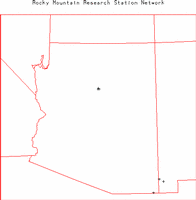 |
| |
|
| KOB WeatherNet - KOB-TV in
Albuquerque, New Mexico operates this network of 53 stations located
primarily at schools throughout New Mexico (50 in New Mexico). The
network provides up to 1-minute observations of air temperature, relative
humidity, wind speed, wind direction, precipitation, and barometric pressure.
For further information visit the
KOB
network page. |
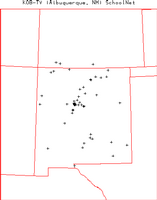 |
| |
|
| KTSM WeatherNet
- KTSM-TV in El Paso, Texas operates this network of 15 stations located
primarily at schools throughout far western Texas and southeastern New
Mexico (7 in New Mexico). The
network provides up to 1-minute observations of air temperature, relative
humidity, wind speed, wind direction, precipitation, and barometric pressure.
For further information visit the
KTSM
network page. |
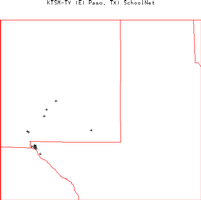 |
| |
|
| State and Local Surface Meteorological Networks |
| |
|
| New Mexico State University (NMSU)
Climate Network - NMSU operates this network of 16 stations with locations
throughout the state of New Mexico. The network provides hourly observations of
air temperature, relative humidity, precipitation, wind speed, wind direction,
solar radiation, soil temperature, and soil moisture. Further information at:
http://weather.nmsu.edu/data/data.htm/. |
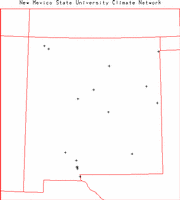 |
| |
|
| City of Albuquerque Parks and Recreation
Network - The City of Albuquerque operates this network of 4 stations with
locations around Albuquerque, New Mexico. The network provides hourly observations
of air temperature, precipitation, and solar radiation. Further information at:
http://weather.nmsu.edu/data/data.htm/. |
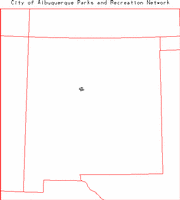 |
| |
|
| Cotton Simulation Model Climate
Network - The Cottom Simulation Model Climate Network consists of 5 stations
with locations mostly in southern New Mexico. The network provides hourly
observations of air temperature, relative humidity, precipitation, wind speed,
wind direction, solar radiation, soil temperature, and soil moisture. Further
information at:
http://weather.nmsu.edu/data/data.htm/. |
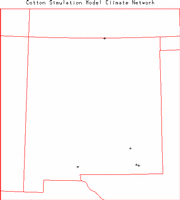 |
| |
|
| Middle Rio Irrigation District
Network - The Middle Rio Irrigation District operates this network of 9
stations located along the Rio Grande in central New Mexico. The network
provides hourly observations of air temperature, relative humidity, wind speed,
wind direction, solar radiation, and soil temperature. Further
information at:
http://weather.nmsu.edu/data/data.htm/. |
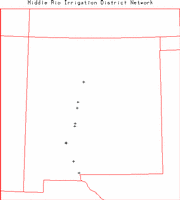 |
| |
|
| Los Alamos National Laboratory (LANL)
Network - LANL operates this network of 11 stations that operate
around LANL in north-central New Mexico. The network includes a 92 m tower
with wind and temperature at four levels (also near-surface measurements
of temperature, moisture, pressure, precipitation, and surface energy balance
terms), a 23 m tower with wind and temperature at two levels (also shortwave
radiation), three 46 m towers with wind and temperature at three levels (also
near-surface measurements of temperature, moisture, precipitation, and
shorwave radiation), and a 36 m tower with wind and temperature at one level
(also near-surface measurements of temperature, moisture, pressure, and
precipitation). The additional sites provide primarily precipitation.
For further information visit the
LANL network page and information on the individual sites
can be found
here. |
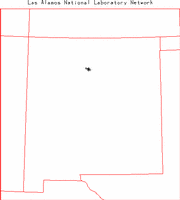 |
| |
|
| Neighborhood Environmental Watch
Network (NEWNET) - LANL, the US Environmental Protection Agency,
and local community operate this network of 21 stations (12 on the LANL
campus) to provide radiological and
meteorological data. The network provides 15-minute observations of
wind speed, wind direction, barometric pressure, air temperature,
relative humidity, precipitation, and radiological parameters.
Further information at:
http://newnet.lanl.gov/. |
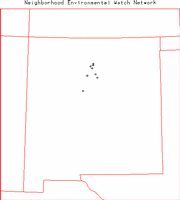 |
| |
|
| White Sands Missle Range (WSMR)
Network - WSMR operates this network of 29 stations that operate
around WSMR in south-central New Mexico. The network provides 15-minute
observations of air temperature, dew point, relative humidity, barometric
pressure, wind speed, wind direction, solar radiation, and precipitation.
Further information at:
http://weather.wsmr.army.mil/default.htm. |
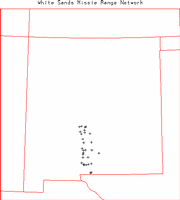 |
| |
|
| Precipitation and Radar Networks |
| |
|
| NOAA/National Centers for Environmental
Prediction (NCEP) Hourly Precipitation Data - NOAA/NCEP routinely develops
a National Multi-sensor Hourly Precipitation Analysis (Stage II) data set from
hourly radar precipitation estimates and from hourly gage reports. The gage data
includes hourly observations from ~4000 gages across the US (66 in New Mexico)
collected by the NOAA River Forecast Centers and sent to NCEP. Further information
on these data is available at:
http://wwwt.emc.ncep.noaa.gov/mmb/ylin/pcpanl/. |
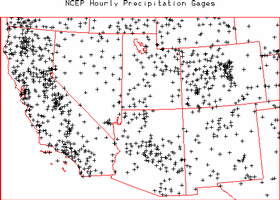 |
| |
|
| Community Collaborative Rain, Hail and Snow Network (CoCoRaHS) - The Colorado
Climate Center at Colorado State University overseas this cooperative network of observers
located throughout New Mexico. The network provides daily observations of
precipitation, snowfall, and snow depth. Hailpad observations are also made at many
locations. For further information visit the
CoCoRaHS home page. |
No map. |
| |
|
| Snowpack Telemetry (SNOTEL) Network - The United States Department of
Agriculture Natural Resources Conservation Service (NRCS) operates this network of 754
stations with locations throughout the mountainous areas of the western US (20 in
New Mexico). The temporal resolution and parameters measured vary by station. Up to hourly
observations of air temperature, precipitation, snow depth, and snow water content are
typically provided. Other parameters that may be available include relative humidity, wind
speed, wind direction, solar radiation, soil moisture, and soil temperature. These data
are archived by the NRCS, Western Regional Climate Center, and other. For further
information visit the
NRCS SNOTEL Data Network
home page or the
Western Regional Climate Center SNOTEL data page or the
US Bureau
of Reclamation SNOTEL page. |
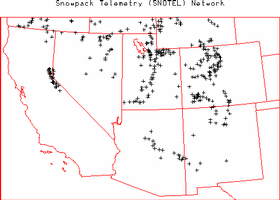 |
| |
|
| USDA/NRCS Snow Survey Program - The USDA/NRCS Snow Survey Program
provides mountain snow course data at approximately 800 locations throughout the
western US. For further information visit the
USDA/NRCS Snow
Course Data Network page and the
USDA/NRCS New Mexico
Snow Survey Program. |
No Map. |
| |
|
| NOAA/NWS Cooperative Observer 15-minute Precipitation Network - The NOAA/NWS
routinely collects 15-minute observations of precipitation from Fisher-Porter and Universal
rain gages operated by 2777 cooperative observers located throughout the US (78 in New Mexico).
These data are archived at NOAA/NCDC as data set TD 3260. For further information visit the
NOAA/NCDC TD3260 page at:
http://ols.nndc.noaa.gov/plolstore/plsql/olstore.prodspecific?prodnum=C00505-TAP-A0001 |
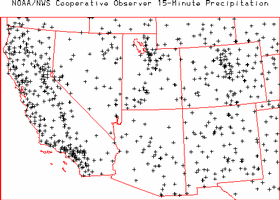 |
| |
|
| Weather Surveillance Radar 1988 Doppler (WSR-88D)
Network - The NOAA/NWS and the Department of Defence operate this network
of 143 WSR-88D radars across the continguous US (2 in New Mexico). The Level II
data are the three meteorological base data quantities (reflectivitiy, mean radial
velocity, and spectrum width) and are recorded at all NWS and most DOD sites.
Level II data are then processed in order to create a number of meteorological analysis
products known as Level III data. Level III data are recorded at the NWS sites. The
Level III products included base reflectivity, base spectrum width, base velocity,
composite reflectivity, echo tops, velocity azimuth display (VAD) wind profile,
vertically integrated liquid (VIL), 1-hour precipitation, storm total precipitation,
hail index overlay, mesocyclone overlay, severe weather probability overlay, storm
structure, storm tracking information overlay, and tornadic vortex signature overlay.
All Level II and III data are archived at NOAA/NCDC. For further information visit
the NOAA/NCDC Radar Resources page at:
http://www.ncdc.noaa.gov/oa/radar/radarresources.html or the NOAA Radar
Operations Center at:
http://www.roc.noaa.gov/. |
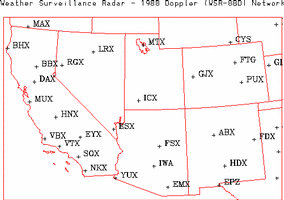 |
| |
|
| Radiation and Flux Networks |
| |
|
| Integrated Surface Irradiance Study (ISIS)
Network - The ISIS network is operated by the NOAA Air Resources
Laboratory (ARL) Surface Radiation Research Branch (SRRB). The network
provides 3 minute observations of downwelling global solar, direct solar,
downwelling diffuse solar and global UVB. There are 9 ISIS sites located
across the US (1 in New Mexico). For further information visit the ISIS
home page at:
http://www.srrb.noaa.gov/isis/. |
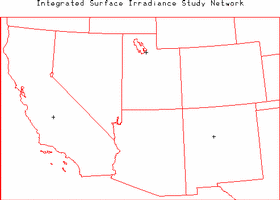 |
| |
|
| Cooperative Network for Renewable Resource
Measurements (CONFRRM) Network - The National Renewable Energy Laboratory
(NREL) oversees this network of 11 radiation stations (1 in New Mexico) with
locations primarily in the southern and eastern US. The network provides 5-minute
observations of global horizontal irradiance, direct normal irradiance, and diffuse
horizontal irradiance. Some of the sites also provide various surface meteorological
parameters. For further information visit the CONFRRM home page at:
http://rredc.nrel.gov/solar/new_data/confrrm/. |
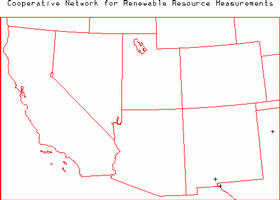 |
| |
|
| Environmental Protection Agency (EPA) Ultraviolet
Monitoring Program (UV-Net) - The EPA operates this network of 20 Brewer
spectrophotometers throughout the US (1 in New Mexico). The network provides observations of
full-sky spectrally resolved solar radiation in the UV-B and UV-A bands. The
irradiance and total column ozone concentrations are derived from these data.
For further information visit the
EPA UV-Net page. |
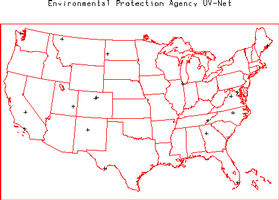 |
| |
|
| United States Department of Agriculture (USDA)
UV-B Monitoring Network - The USDA operates this network of 29 stations
with locations throughout the US (1 in New Mexico). The network provides
3-minute observations of spectral total/direct/diffuse radiation, air temperature,
relative humidity, solar radiation, barometric pressure, and photosynthetically
active radiation. For further information visit the
USDA UV-B Monitoring page. |
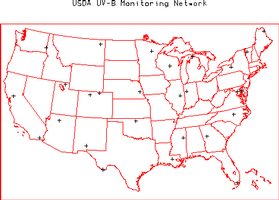 |
| |
|
| Soil Networks |
| |
|
| Soil Climate Analysis Network (SCAN) - The SCAN is operated by the United
States Department of Agriculture (USDA) Natural Resources Conservation Service (NRCS). The
network provides hourly observations of air temperature, relative humidity, wind speed,
wind direction, solar radiation, precipitation, barometric pressure, snow water content,
snow depth, soil temperature (at 2, 4, 8, 20, and 40 cm depths), and soil moisture (at 2, 4,
8, 20 and 40 cm depths). The 80 SCAN stations are located across the US in primarily
agricultural regions (1 in New Mexico). For further information visit the
SCAN home page. |
 |
| |
|
| Hydrology Networks |
| |
|
| United States Geological Survey (USGS) Streamflow
Network - The USGS (part of the US Department of the Interior) operates this
network of 7237 streamflow gages (84 in New Mexico) at locations throughout the US.
The network provides hourly or more frequent observations of stage (water level) from
which discharge (flow) is comuputed using a stage-discharge rating relation. The
rating is defined by occasional direct current-meter measurements of discharge. All
data are available through the USGS and the district offices in each state. Many of
these gages provide realtime data
relayed via the GOES satellite data collection system. The realtime data are
provisional data that have not been reviewed or edited. These realtime data
may be subject to significant change and are not citeable until reviewed and approved
by the USGS. Realtime data may be changed after review because the stage-discharge
relationship may have been affected by: 1) backwater from ice or debris; 2) algal and
aquatic growth in the stream; 3) sediment movement; and 4) malfunction of recording
equipment. Each station record is considered provisional until the data are
published. The data are usually published with 6 months of the end of the water year
(1 October to 30 September). Data users are cautioned to consider carefully the
provisional nature of the information before using it. For further information on the
USGS stremflow network visit the USGS Water Resources of the United States page at:
http://water.usgs.gov/ or the
USGS Arizona District Office home page at:
http://az.water.usgs.gov/. |
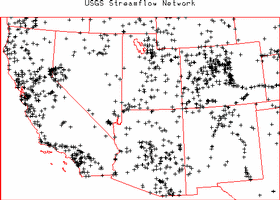 |
| |
|
| US Army Corps of Engineers (USACE) Albuquerque
District Reservoir Data - The USACE Albuquerque District provides daily
reports from 7 reservoirs within New Mexico. They provide daily observations of
reservoir elevation, reservoir storage, stage, flow evaporation, precipitation,
and air temperature. Further information is available at the USACE Albuquerque
District Reservoir Water Control Section home page at:
http://www.spa.usace.army.mil/wc/. |
No map. |
| |
|
| Upper Air Networks |
| |
|
| NOAA/NWS Radiosonde Network Low Vertical Resolution Data - The NOAA/NWS
typically releases radiosondes twice per day at 0000 and 1200 UTC at 69 locations throughout
the US (2 in New Mexico). During special weather situations the NWS can request to release
additional radiosondes at off-times (e.g. 1800 UTC). The low resolution data is sent out
over the Global Telecommunications System (GTS) and provides mandatory and significant level
observations of pressure, altitude, temperature, dew point, wind speed, and wind direction.
There are 3 types of radiosondes utilized within the US network, Vaisala, VIZ (or Sippican),
and Microsonde. These data are archived by NOAA/NCDC and other organizations. For further
information on the NWS Radiosonde network visit the
NWS Upper-air Observations Program
home page. A several year archive of GTS upper air data is available at the
NOAA/FSL Radiosonde Database. |
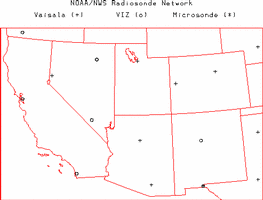 |
| |
|
| NOAA/NWS Radiosonde Network High Vertical Resolution Data - The same
radiosonde locations mentioned in the previous data set also provide a 6-second vertical
resolution data set that provides observations of pressure, temperature, altitude,
relative humidity, and azimuth and elevation angles. UCAR/JOSS has developed software
to derive 6-second vertical resolution winds from the angle data. These data are
archived by NCDC and UCAR/JOSS. |
 |
| |
|
| NOAA Profiler Network (NPN) - The
NOAA/Forecast Systems Laboratory (FSL) operates this network of 32 404 MHz wind
profilers primarily across the central portion of the United States (3 in New Mexico).
Each site provides 6-minute and hourly vertical profiles of wind speed and wind
direction. Additionally, 11 of the NPN sites have a collocated Radio Acoustic
Sounding System (RASS) that provides 6-minute and hourly vertical profiles of
virtual temperature (1 in New Mexico). For further information visit the
NPN home page.
An archive of the hourly wind profiles is available from
NCAR/SCD. |
 |
| |
|
| Cooperative Agency Profiler (CAP) Network - The NOAA/FSL ingests data
from wind profilers and RASS operated by a number of cooperating agencies. Most of
these profilers are 915 MHz, but some are 449 or 50 MHz. Most provide hourly observations
of wind speed and direction. The number and location of these can vary through time. As
this is being written the network included 58 locations within the US (3 in New Mexico).
Most of the sites are along the US West Coast and in the northeastern US. For further
information visit the CAP home page at:
http://www.profiler.noaa.gov/jsp/aboutCap.jsp. |
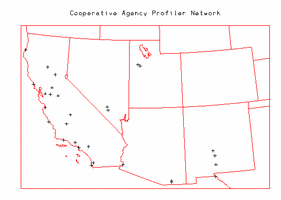 |
| |
|
| Ground Based Global Positioning System (GPS) Meteorology Demonstration Network
(GPS-MET) - The NOAA/FSL ingests data from 323 GPS locations around the US
operated by many different agencies (5 in New Mexico). Typically each location provides
30-minute observations of integrated precipitatable water along with a number of surface
meteorology parameters (air temperature, relative humidity, barometric pressure, etc).
For further information visit the
GPS-MET home page. |
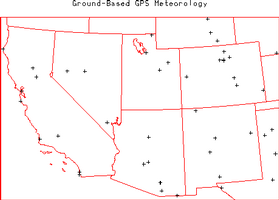 |
| |
|
| Other Networks |
| |
|
| Aerosol Robotic Network (AERONET) - AERONET is an optical ground-based aerosol
monitoring network and data archive supported by NASA's Earth Observing System. The network
hardware consists of identical automatic sun-sky scanning spectral radiometers owned by national
agencies and universities. Data from this collaboration provides globally distributed (3 in New Mexico)
near real time observations of aerosol spectral optical depths, aerosol size distributions and precipitable
water. For further information visit the
AERONET home page. |
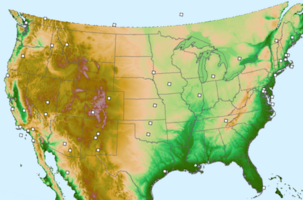 |



















































